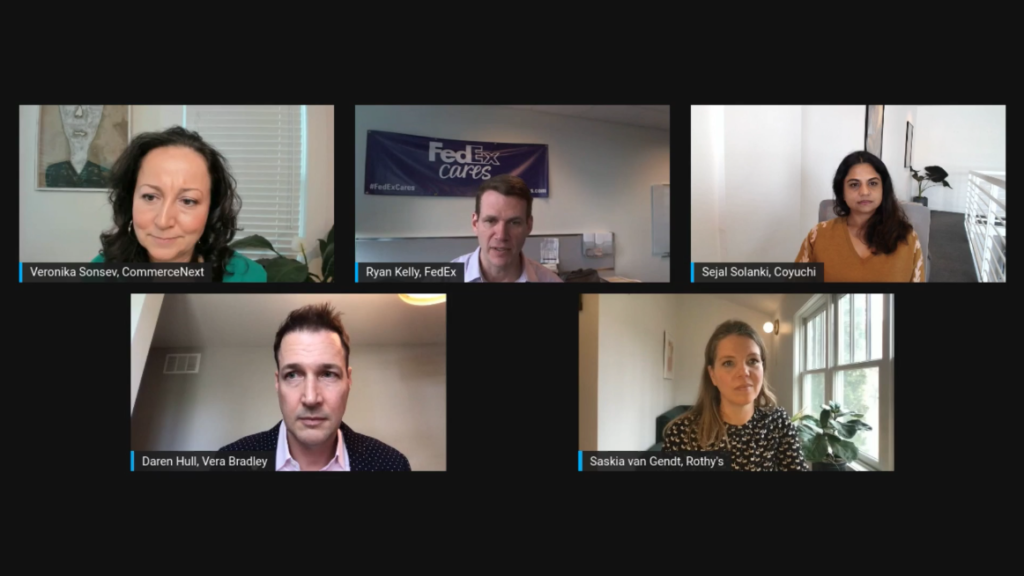We’re in a climate crisis and consumers are looking for more and more ways to decrease their footprint in all aspects of life—and they expect companies to do the same. Working towards better sustainability is not only the right thing to do for consumers, but also for the planet. In this week’s webinar, Ryan P. Kelly, VP of Ecommerce & Alliance Marketing at FedEx Services shared industry data on sustainability, then was joined by Daren Hull, President at Vera Bradley, Saskia van Gendt, Head of Sustainability at Rothy’s and Sejal Solanki, VP, Ecommerce & Marketing at Coyuchi for a panel discussion on how retailers can start incorporating sustainable practices into their businesses.
Watch the replay here or read the recap below.

SESSION RECAP
Kelly made the argument that consumers want companies to take responsibility, but in addition to taking steps to become sustainable, retailers need to educate the consumer to influence their behavior—consumers should know which options are more sustainable, what their choices mean and what progress a brand is working towards.
Over the last year, while people have been at home, there has been an increase in online shopping. Even though carbon emissions from online shopping are on average 36% lower than those produced by in-store shopping, there is more that can be done to decrease the carbon footprint from online shopping. The three biggest components of ecommerce that have a large impact on the environment are: delivery speed, packaging (shipping) and returns. Kelly dove into each of these areas’ importance with solutions to improve sustainability.
Delivery Speed
There is a misconception in retail that consumers’ number one priority when online shopping is quick delivery. Only about one third of consumers use same-day or next-day shipping—it’s a niche delivery type that will most likely trend downward. According to research, consumers actually care most about avoiding shipping costs. Therefore, it’s important to provide choice but also incentivize customers to choose slower options that save the customers money. Research shows that consumers would choose an environmentally better option if they had the information about eco-friendly delivery options available.
Packaging
When it comes to packaging and shipping, the least sustainable package is one that’s damaged—while eco-friendly packaging made out of recycled materials is a good change, these materials are sometimes weaker and result in damaged packages. Therefore, it’s important to focus on the package design to make it as durable as a non-eco friendly option.
Returns
Consumers think retailers and carriers are responsible for the environmental impact of returns, excepting if the return was due to bracketing (ordering multiple sizes with the intention of returning the ones that don’t fit). The best way to help this category is reframing the typical ”How do we reduce returns?” question and instead asking, “How do we get consumers to keep the products they buy?”
PANEL DISCUSSION
Sustainability can be overwhelming because it is so broad. The panelists broke down sustainability into several categories to give advice on how retailers can get started right now.
Getting Into Sustainability
Sometimes the biggest problem for getting into sustainability is making the business case for it. Hull advises that “you have to treat sustainability like any other initiative.” This means:setting realistic goals, understanding what you’re committing to and how to make real progress and measure the goals made. When you build the goal of sustainability into your team and culture, the team will come up with great ideas and understand that driving growth and sustainability are not mutually exclusive.
It’s important to be transparent with your customers when it comes time to market your new sustainability strategy. It will come across authentically if your brand can explain what you’re trying to do, where you’re going and how you’re doing it. Instead of just trying to connect with Gen Z and show how your brand is suddenly marketed towards them, explain the benefits to your customer base. Sometimes a casual approach is the best one.
5 Steps To Take Now
Starting as a small business is easier because you can make choices at a smaller scale, build a foundation and grow from a sustainable base. However, even big businesses trying to take the first step can make changes.
Here are 5 easy ways that brands can be more sustainable:
- Take a materiality assessment to look at your business, what/how you’re producing and the biggest areas you can make improvements in.
- Change what you use in-store: switch to tote bags or post-consumer usable bags.
- Re-design packaging to include less fluff or non-essential decorations.
- Incentivize slower delivery with lower shipping costs (and provide the value equation of what people are trading off for).
- Improve the return process to minimize extra shipping or materials used.
Advanced Strategies
For those more advanced in sustainability, there are still further steps to take. Coyuchi implemented circularity, the practice of a brand accepting old products from customers (rather than disposing of them) and re-selling or reusing the materials to create new products. Their program, 2nd Home Take Back™, incentivizes customers to return their old linens and receive a discount for their next purchase. Afterward, the company creates new sheets out of the products they receive, sells them at a lower price and recycles the leftover materials to make blankets. This practice can help with waste and carbon mitigation—Coyuchi has collected 44,000 pounds of fabric since the initiative launched in 2017.
Rothy’s is also working towards circularity, with a recycling pilot to test the best ways to dismantle their shoes, recover the main components and convert into new products. As they move towards carbon neutrality by 2023, they will improve efficient transportation and packaging, among other things.
Sustainability should be a priority for all—use the tips from our speakers to make small changes that will have a positive impact. Make sure to keep staying tuned in to the CommerceNext Webinars as we share relevant industry information to help your brand grow and stay relevant.
Related Posts
-
AI & AR: The New “It” Factor For Retail Customer Experience
In the last year, pretty much everyone started purchasing from…
-
Building Loyalty with Newly Acquired Customers
Many brands experienced an influx of new customers due to…
-
Using Search to Improve Ecommerce and Own the Customer Journey
Owning the customer journey is key to cultivating loyalty and…




